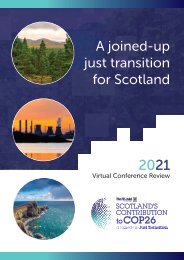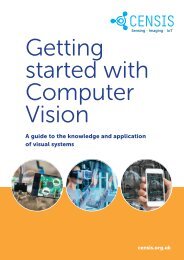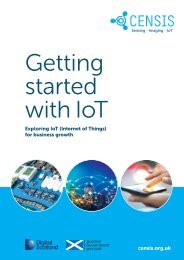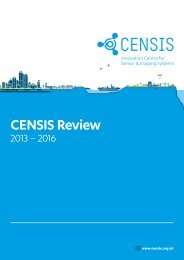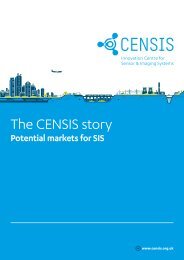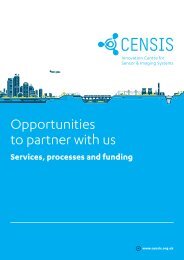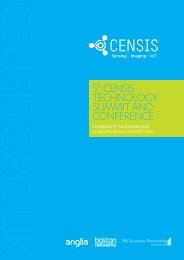CENSIS white paper: Intellectual Property in Business
2023: This CENSIS white paper sets out to make the topic of IP more approachable, less intimidating and more manageable, offering experience-based advice and methods are are designed to help businesses structure their IP- related issues and makes the best of their IP. Covering: The role of IP, IP management during growth, IP strategy for expanding companies and corporates, Business IP Canvas - merging IP with your business model.
2023: This CENSIS white paper sets out to make the topic of IP more approachable, less intimidating and more manageable, offering experience-based advice and methods are are designed to help businesses structure their IP- related issues and makes the best of their IP.
Covering:
The role of IP, IP management during growth, IP strategy for expanding companies and corporates, Business IP Canvas - merging IP with your business model.
You also want an ePaper? Increase the reach of your titles
YUMPU automatically turns print PDFs into web optimized ePapers that Google loves.
<strong>Intellectual</strong> <strong>Property</strong> <strong>in</strong> Bus<strong>in</strong>ess: IP basics, IP management, IP strategy<br />
Bus<strong>in</strong>ess IP Canvas - Merg<strong>in</strong>g IP with your bus<strong>in</strong>ess model (cont<strong>in</strong>ued)<br />
Market segments (see Appendix 2)<br />
In the ‘Bus<strong>in</strong>ess IP Canvas’, the ‘customer segment’<br />
block is renamed as ‘market segments’, mov<strong>in</strong>g<br />
the focus away from the customers and users your<br />
company aims to serve and reach.<br />
This section asks for a wide range of <strong>in</strong>formation<br />
about IP practices common <strong>in</strong> the target market. Your<br />
knowledge and understand<strong>in</strong>g of the IP activities of<br />
your direct and <strong>in</strong>direct competitors, potential licensees<br />
and the general acceptance of IP <strong>in</strong> the specific<br />
market are other key elements <strong>in</strong> develop<strong>in</strong>g an IP<br />
strategy. For example, <strong>in</strong> the biotech market, IP rights<br />
are highly recognised and respected. In contrast to<br />
that is the coffee <strong>in</strong>dustry where patents do exist (see<br />
Nestle’s patents for the Nespresso mach<strong>in</strong>e and caps),<br />
but the <strong>in</strong>dustry is not particularly bothered with IP<br />
litigation despite a number of unauthorised copies of<br />
IP-protected products. And yet, as it is reported some<br />
companies choose to expand their IP portfolios for<br />
strategic and not enforcement purposes. 96<br />
When it comes to learn<strong>in</strong>g about the IP practices of<br />
your competitors, it’s not so much about do<strong>in</strong>g the<br />
same th<strong>in</strong>g as about understand<strong>in</strong>g how they play their<br />
game and how their IP-related activities correspond<br />
with their bus<strong>in</strong>ess model and strategy.<br />
The better you know the target market, the clearer<br />
perspective you will have when it comes to IP strategy.<br />
Other blocks of the Bus<strong>in</strong>ess IP Canvas (see<br />
Appendix 1)<br />
The rema<strong>in</strong><strong>in</strong>g canvas blocks ask more diverse<br />
questions relat<strong>in</strong>g to IP matters. The questions are<br />
<strong>in</strong>tended to cover as many bus<strong>in</strong>ess activities as<br />
possible and to <strong>in</strong>dicate IP issues that, if unsolved or<br />
neglected, could lead to bigger issues affect<strong>in</strong>g your<br />
commercialisation plans.<br />
Key partners: You build partnerships to ga<strong>in</strong><br />
resources or reduce risk. You should record IP<br />
<strong>in</strong>formation from this block, firstly, to track the (co-)<br />
users of your IP and, secondly, to have clarity about any<br />
third-party IP implemented <strong>in</strong> your solution.<br />
Key resources: This block covers your company’s IP<br />
assets. The entry should be a list of all identified IP rights<br />
relevant for your solution (owned by your company<br />
and/or from third parties). If you are already record<strong>in</strong>g<br />
your IP rights <strong>in</strong> a more formalised way – for example,<br />
<strong>in</strong> an IP register – only <strong>in</strong>dicate the location of the IP<br />
register.<br />
Key activities: This po<strong>in</strong>t covers other critical IPrelated<br />
tasks that are not covered under other canvas<br />
blocks, such as apply<strong>in</strong>g for new IP rights, acquir<strong>in</strong>g IP<br />
rights from third parties or review<strong>in</strong>g your obligations<br />
result<strong>in</strong>g from R&D projects.<br />
Customer relationships: To ma<strong>in</strong>ta<strong>in</strong> strong<br />
customer relationships you may decide to <strong>in</strong>volve your<br />
customers <strong>in</strong> technology/product development, just<br />
as <strong>in</strong> co-creation. This query focuses on IP aspects<br />
of such customer engagement, be it <strong>in</strong> B2C or B2B<br />
relationships.<br />
Channels: Distribution channels create another<br />
IP challenge. You may sign distribution agreements<br />
<strong>in</strong>clud<strong>in</strong>g IP licens<strong>in</strong>g or utilise onl<strong>in</strong>e content<br />
generated by third parties. It is important to check the<br />
ownership of the content and the scope of exploitation<br />
rights. The questions under this section guide you <strong>in</strong><br />
how to cover these various aspects.<br />
Cost structure: IP management (with the diverse<br />
tasks it <strong>in</strong>volves) <strong>in</strong>curs costs. You should consider these<br />
costs <strong>in</strong> your cost structure and pric<strong>in</strong>g policy. Equally<br />
important is to determ<strong>in</strong>e your budget for apply<strong>in</strong>g and<br />
ma<strong>in</strong>ta<strong>in</strong><strong>in</strong>g IP rights. It is advisable to <strong>in</strong>clude costs<br />
relat<strong>in</strong>g to measures for trade secret protection.<br />
Revenue streams: Technology licens<strong>in</strong>g is often<br />
named as one of the revenue streams which you should<br />
consider as your bus<strong>in</strong>ess model. When you license<br />
your technology, you license your IP rights that cover a<br />
specific solution. You could license a complete solution<br />
or selected modules – this depends on the market<br />
response.<br />
96<br />
Jenn Chen, ‘<strong>Intellectual</strong> <strong>Property</strong> In Coffee: A Global Game Of Clones’ (Sprudge, 10 October 2018)<br />
accessed 2 December 2022.<br />
51






